
The Philippine Department was a regular United States Army organization whose mission was to defend the Philippine Islands and train the Philippine Army. On 9 April 1942, during World War II, the organization surrendered to the Japanese. The Department and its sub-units were predominantly under the command of American officers, including an American general, while the majority of the troops were enlisted Filipinos, known as the Philippine Scouts (PS). The primary force of this Department was the Philippine Division. Of the 22,532 troops, 10,473 were members of the Philippine Division itself.

The Philippine Scouts was a military organization of the United States Army from 1901 until after the end of World War II. These troops were generally Filipinos and Filipino-Americans assigned to the United States Army Philippine Department, under the command of American commissioned officers. Philippine Scout units were given the suffix "(PS)", to distinguish them from other U.S. Army units.
The Office of the Military Advisor to the Commonwealth Government (OMACG) was created in 1935 upon the initiative of President Manuel L. Quezon by the Philippine and American governments for the purposes of developing a system of national defense for the Commonwealth of the Philippines by 1946. OMACG's recommendations were adopted by the Philippine National Assembly in Commonwealth Act Number 1, the National Defense Act of 1935.
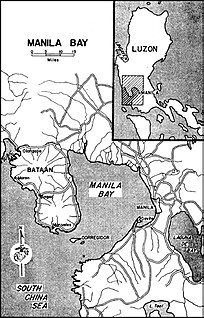
The Harbor Defenses of Manila and Subic Bays were a United States Army Coast Artillery Corps harbor defense command, part of the Philippine Department of the United States Army from circa 1910 through early World War II. The command primarily consisted of four forts on islands at the entrance to Manila Bay and one fort on an island in Subic Bay.

Philippine Division, or from 1946–1947 the 12th Infantry Division, was the core U.S. infantry division of the United States Army's Philippine Department during World War II. On 31 July 1941, the division consisted of 10,473 troops, mostly enlisted Filipinos, known as the Philippine Scouts who formed the 45th and 57th US Infantry Regiments. All of the division's enlisted men, with the exception of the 31st Infantry Regiment, and various military police and headquarters troops, were Philippine Scouts.
A Corps area was a geographically-based organizational structure of the United States Army used to accomplish administrative, training and tactical tasks from 1920 to 1942. Each corps area included divisions of the Regular Army, Organized Reserve and National Guard of the United States. Developed as a result of serious mobilization problems during World War I, this organization provided a framework to rapidly expand the Army in time of war or national emergency such as the Great Depression.
An officer candidate school (OCS) is a military school which trains civilians and enlisted personnel in order for them to gain a commission as officers in the armed forces of a country. How OCS is run differs between countries and services. Typically, officer candidates have already attained post-secondary education, and sometimes a bachelor's degree, and undergo a short duration of training which focuses primarily on military skills and leadership. This is in contrast with a military academy which includes academic instruction leading to a bachelor's degree.

The Philippines campaign, also known as the Battle of the Philippines or the Fall of the Philippines, was from December 8, 1941, to May 8, 1942, the invasion of the Philippines by the Empire of Japan and the defense of the islands by United States and the Philippine Armies during World War II.
The Commonwealth of the Philippines was attacked by the Empire of Japan on 8 December 1941, nine hours after the attack on Pearl Harbor. Although it was governed by a semi-independent commonwealth government, the United States of America controlled the Philippines at the time and possessed important military bases there. The combined Filipino-American army was defeated in the Battle of Bataan and the Battle of Corregidor in April 1942, but guerrilla resistance against the Japanese continued throughout the war. Uncaptured Filipino army units, a communist insurgency, and supporting American agents all played a role in the resistance. Due to the huge number of islands, the Japanese never occupied many of the smaller and more minor islands. Japanese control over the countryside and smaller towns were often tenuous at best.
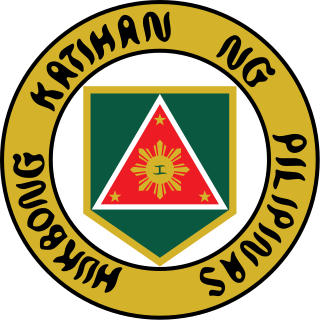
The Philippine Army (PA) is the main, oldest and largest branch of the Armed Forces of the Philippines (AFP), responsible for ground warfare and as of 2021 had an estimated strength of 101,000 soldiers backed by 100,000 ready reserves. The service branch was established on December 21, 1935, as the Philippine Commonwealth Army. The Philippine Army has engaged in many conflicts including the ongoing Communist rebellion in the Philippines, the Moro conflict and, alongside other national military forces, in conflicts of international scope.
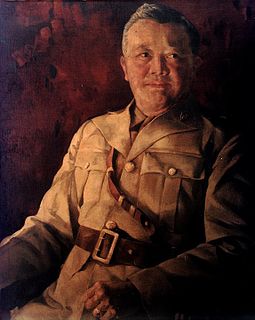
Vicente Podico Lim was a Filipino brigadier general and World War II hero. Lim was the first Filipino graduate of the United States Military Academy at West Point. Prior to the establishment of the Philippine Army, he served as an officer in the Philippine Scouts. During the Battle of Bataan, Lim was the Commanding General of the 41st Infantry Division, Philippine Army (USAFFE). After the fall of the Philippines he contributed to the Filipino resistance movement until his capture and subsequent execution.

The Armed Forces of the Philippines Officer Candidate School, formerly known as the School for Reserve Commission, is a military school located at Camp O'Donnell, Capas, Tarlac for the Philippine Army Officer Candidate School; Fernando Air Base in Lipa City, Batangas for the Philippine Air Force Officer Candidate School; and Naval Station Leovigildo Gantioqui in San Antonio, Zambales for the Philippine Navy Officer Candidate School. It was established in the Philippines for training future officers of the Armed Forces of the Philippines (AFP).

The Reserve Command is a major support command of the Philippine Army. It was created for the sole purpose of reserve force management, organization and Government Arsenal procurement.

The U.S. Army Coast Artillery Corps (CAC) was an administrative corps responsible for coastal, harbor, and anti-aircraft defense of the United States and its possessions between 1901 and 1950. The CAC also operated heavy and railway artillery during World War I.
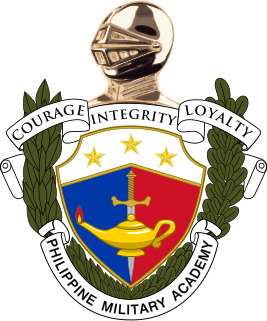
The Philippine Military Academy also referred to by its acronym PMA is the premier military academy for Filipinos aspiring for a commission as a military officer of the Armed Forces of the Philippines (AFP). It was established on December 21, 1936, by the virtue of National Defense Act of 1935. It is patterned after the United States Military Academy, in West Point, New York. The academy is located in the city of Baguio, and serves as the primary training school for future officers of the AFP.

Fort McKinley is a former United States Army coastal defense fort on Great Diamond Island, Maine in Casco Bay, which operated from 1873 to 1947. It was named for President William McKinley. It included a sub-post, Fort Lyon, on Cow Island, just north of Great Diamond Island. Fort Lyon was named for Nathaniel Lyon. Both forts were part of the Coast Defenses of Portland, renamed the Harbor Defenses of Portland in 1925, a command which protected Portland's port and naval anchorage 1895-1950. In 1946 Fort Lyon was closed and turned over to the City of Portland. After Fort McKinley's closure it was transferred to the United States Navy, which sold the site to private interests in 1961. The Fort McKinley Historic District was listed on the National Register of Historic Places in 1985.
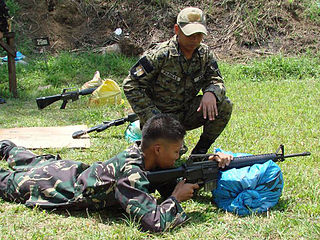
Reserve Officers' Training Corps (ROTC) in the Philippines is one of three components of the National Service Training Program, the civic education and defense preparedness program for Filipino college students. ROTC aims to provide military education and training for students to mobilize them for national defense preparedness. Its specific objectives include preparation of college students for service in the Armed Forces of the Philippines in the event of an emergency and their training to become reservists and potential commissioned officers of the AFP.

Conscription in the Philippines has been implemented at several points in the country's history. As of 2022, no mandatory conscription is in effect in the Philippines and military service is entirely voluntary as stated in the 1987 constitution. However, there are calls for mandatory conscription by Incumbent Vice President Sara Duterte.
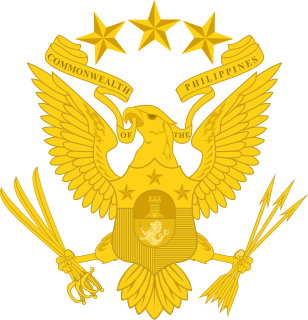
The Philippine Army was established on December 21, 1935, as the Army of the Philippines, with a general headquarters in Manila, and units and formations based throughout the provinces of the Philippines.

The University of Santo Tomas Golden Corps of Cadets (UST-GCC) also referred to as the UST ROTC Unit is a Reserve Officers' Training Corps unit implementing one of the optional components of the Philippines' National Service Training Program (NSTP) in the University of Santo Tomas. The NSTP is a civic education and preparedness program for college students, the ROTC component of which aims to provide military education and training to mobilize them for national defense preparedness.















